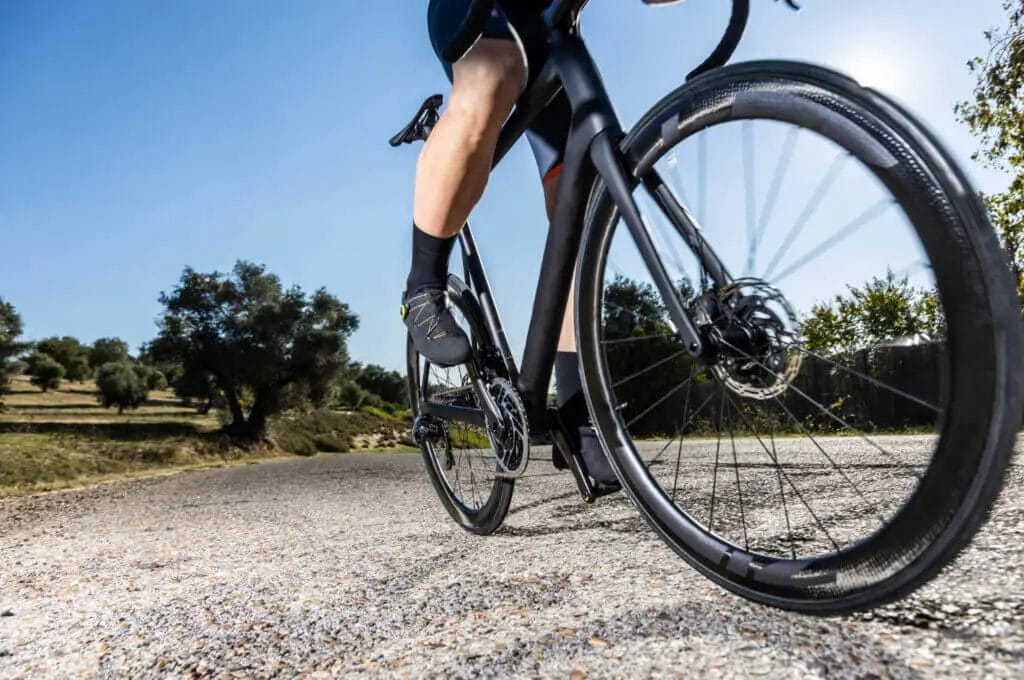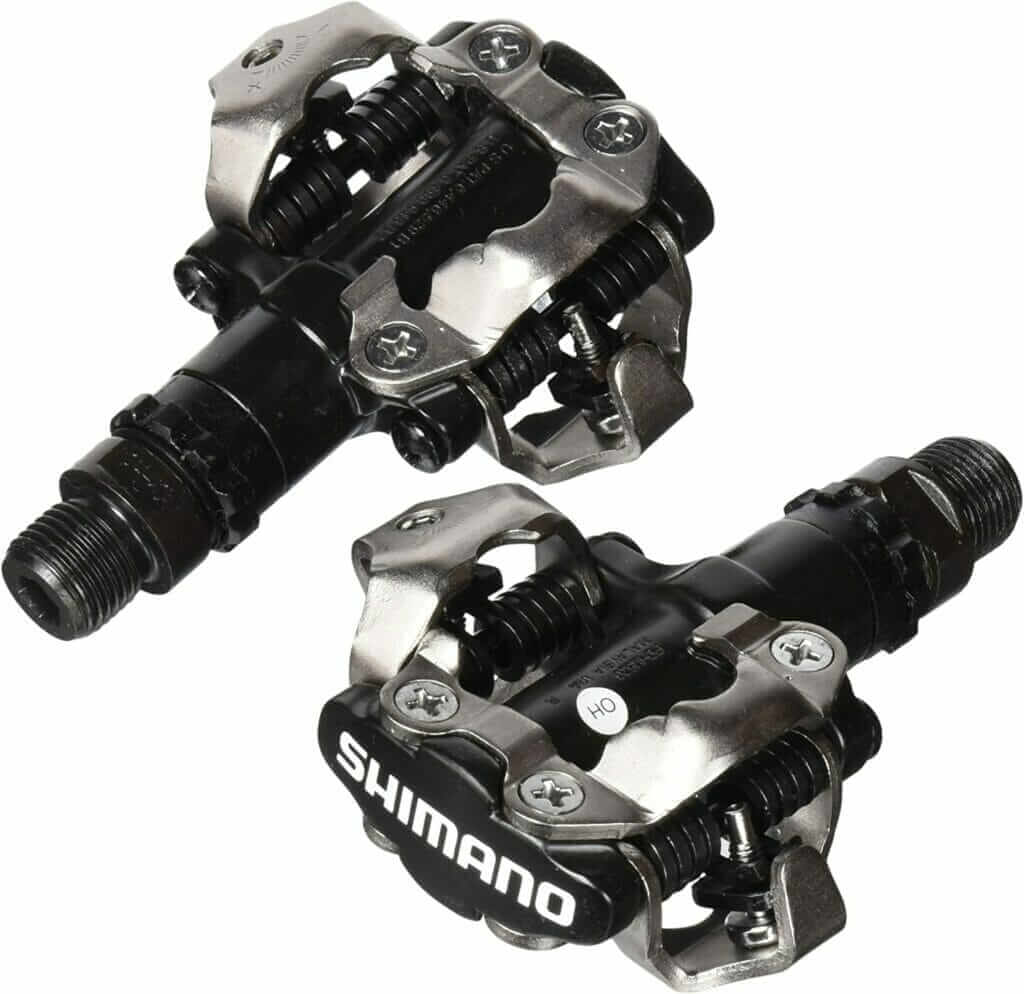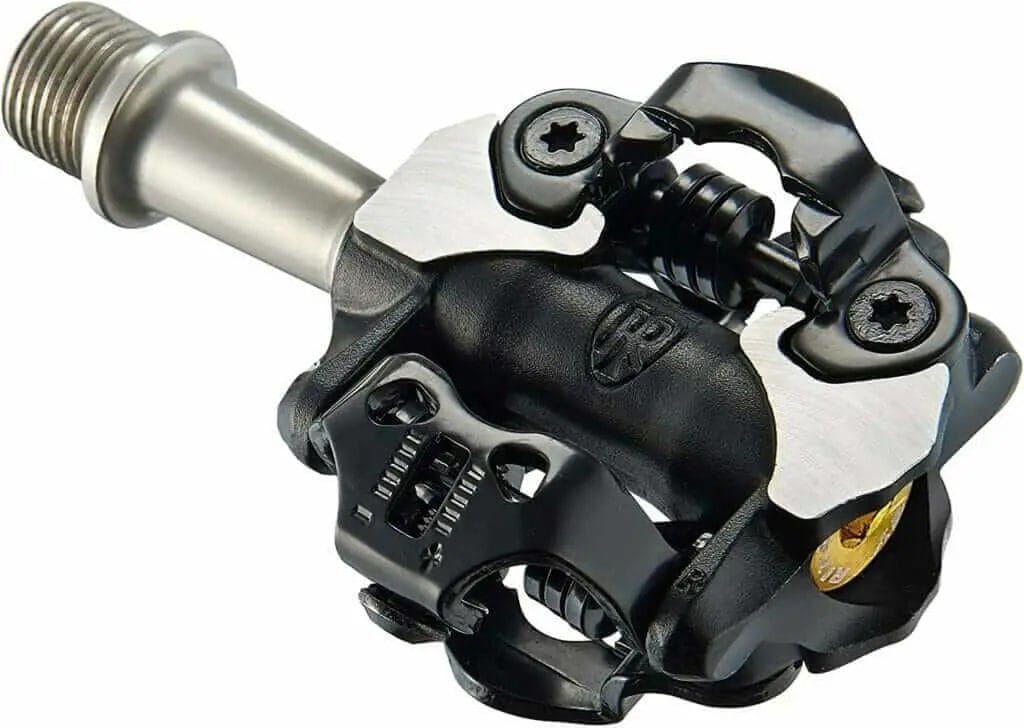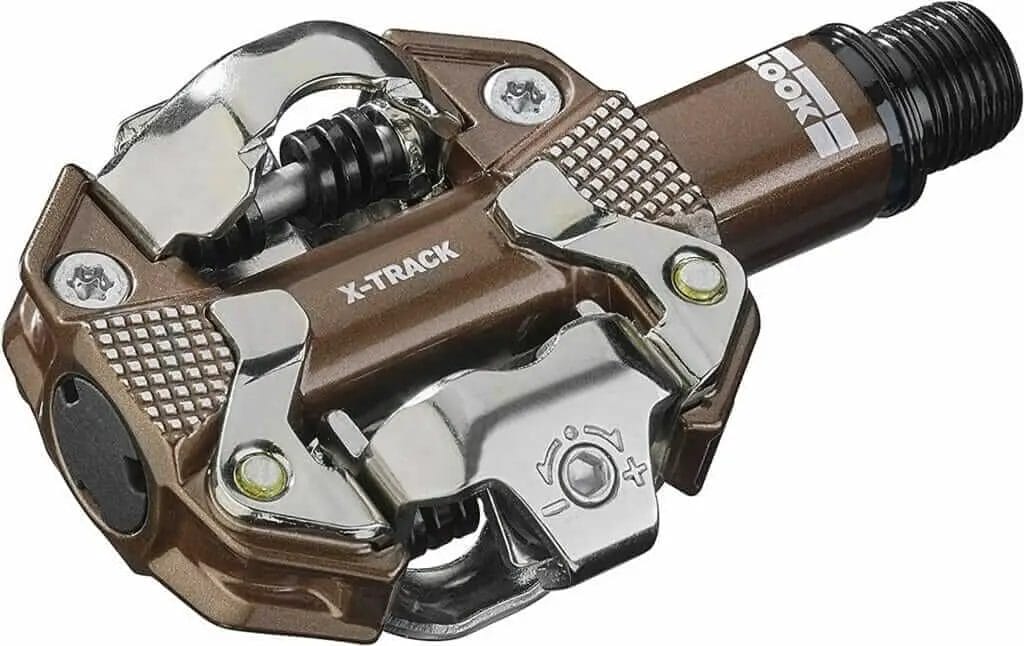Last Updated on May 28, 2023 by Vinson Lozano
As a passionate cyclist, you’ve probably heard of the latest craze in the cycling world: gravel biking. This fantastic hybrid of road and mountain biking has taken the cycling community by storm, attracting riders who crave the thrill of adventure and exploration, and the undeniable freedom that comes with it.
One of the burning questions on everyone’s mind when diving into this brave new world, is what pedals are best suited for gravel biking? Are you better off sticking with your trusty road pedals or venturing into something entirely different? You wouldn’t want to take a wrong turn, getting lost in a realm of online reviews, only to find yourself merely spinning your wheels, right? Fear not, explorers, as your trusty guide is here to help you navigate the rough and smooth terrain of gravel biking pedals.
Through this journey, we’ll conquer the myths, the must-haves, and everything in between. So saddle up, clip in, and let’s ride towards the ultimate pedal experience for your gravel biking escapades!

Top-rated gravel bike pedals for 2023: Our expert picks
When it comes to top-rated gravel bike pedals for 2023, there are several options that have stood out for their performance, durability, and value.
One such pedal is the Shimano PD-M520, which has earned high praise for its affordability and reliability.

These entry-level clipless pedals share the same entry and release mechanism as pricier Shimano models, but with added weight due to the use of different materials. Despite their weight, the PD-M520 pedals are known for their durability, making them a popular choice for gravel riders on a budget.
Another great option for gravel biking enthusiasts is the Ritchey Comp XC, featuring a stylish and svelte SPD pedal design without compromising on value. Compatible with standard SPD cleats, these pedals provide ease of use, allowing riders to quickly clip in and out. While they are available in various colors, it is worth noting that the paint may be prone to scuffing. Still, their overall performance and affordability make them a top contender in the market.

The Shimano PD-ME700 is an excellent choice for those seeking greater foot support. With a larger surface area than some other gravel bike pedals, they do tend to be heavier. However, the PD-ME700 offers adjustable entry and release tension on the pedal body, ensuring a comfortable riding experience. Their quality build and serviceability guarantee that these pedals can last for years, providing good value for the cost.

Clipless vs. flat pedals for gravel riding: Pros and cons
When it comes to gravel biking, one of the most debated topics among riders is whether to use clipless or flat pedals. Both options have their pros and cons, and the choice ultimately depends on individual preferences, as well as the type and level of riding one plans to engage in.
Clipless pedals are a popular choice among gravel bike enthusiasts, mainly because they offer secure foot retention and improved pedaling efficiency. By being attached to the pedal, riders can maintain a smooth and consistent pedaling cadence. This, in turn, allows for better overall control and stability on uneven terrain. Additionally, these pedals enable riders to apply power throughout the entire pedal stroke, thereby increasing climbing efficiency and speed on flats.
On the other hand, flat pedals are favored by some gravel riders for their ease of use and versatility. Being able to quickly put a foot down when navigating rough or technical terrain can be an advantage in maintaining balance and control. Another benefit of flat pedals is their compatibility with a wide range of footwear, allowing riders to choose the most comfortable option for their specific riding style. Some riders also appreciate the flexibility of being able to switch between clipped-in and unclipped positions while riding, depending on the situation.
In summary, there may not be a definitive answer to the clipless vs. flat pedals debate as it largely depends on personal preferences and the type of gravel riding one plans to undertake. It is worth considering both options and, if possible, testing each pedal system before making a decision.
MTB vs. gravel bike pedals: How to choose the right type
When it comes to choosing pedals for your gravel bike, you might find yourself wondering if there’s a significant difference between mountain bike (MTB) pedals and gravel bike-specific pedals. Both types cater to off-road adventures, but there are some key factors to consider before making your decision.
Firstly, MTB pedals are generally built for more aggressive trail riding where the terrain might be rougher and more technical. They offer excellent mud-shedding capabilities and provide optimal grip and control, even in adverse conditions. On the other hand, gravel bike pedals are designed with versatility in mind, making them suitable for a variety of surfaces, from dirt tracks to paved roads. These pedals also prioritize weight savings, easier engagement, and efficient power transfer.
Another factor to consider is compatibility with your cycling shoes. Since gravel riders often use a mix of road and off-road gear, it’s essential to ensure that your pedals are compatible with your preferred footwear. MTB pedals utilize a 2-bolt cleat system which works well with mountain and gravel bike shoes, while gravel-specific pedals might offer both 2 and 3-bolt cleat options, accommodating road shoes as well.
In summary, when choosing the right pedals for your gravel bike, it’s crucial to consider your riding style, the terrain you predominantly ride on, and your gear preferences. If you frequently tackle technical trails and require extra grip, MTB pedals might be the perfect choice. However, if you want a more versatile pedal that caters to a variety of riding conditions and offers easier engagement, look no further than gravel-specific pedals. Ultimately, the right decision comes down to your personal needs and preferences.
Lightweight, double-sided pedals: Why they’re preferred for gravel
Lightweight, double-sided pedals are the preferred choice for gravel biking enthusiasts due to their numerous advantages. These pedals offer an optimum balance between performance and versatility, making them perfect for off-road adventures. Gravel riding involves traversing diverse terrains, including dirt, dust, and mud, which can put a strain on the pedals and affect their performance. Lightweight, double-sided pedals are specifically designed to cope with these challenges and provide a seamless riding experience over any terrain.
One of the key reasons why lightweight, double-sided pedals are popular among gravel cyclists is their ease of use. Since these pedals can be clipped in from both sides, riders can quickly and effortlessly engage and disengage from them while navigating rough surfaces or making sudden stops. This can prove to be an invaluable asset, especially when tackling unpredictable landscapes and dealing with potentially hazardous conditions.
Another advantage of lightweight, double-sided pedals is their exceptional durability and resistance to wear and tear. These pedals are constructed using high-quality materials that can withstand the rigors of off-road cycling, ensuring their long-lasting performance even in the most challenging environments. Additionally, their ability to cope with mud and debris prevents clogging and ensures smooth operation throughout the ride.
Finally, the double-sided design of these pedals also allows riders to tailor their cleat setup according to preference and comfort. With various options available for adjustable float, release tension, and cleat compatibility, cyclists can customize the pedal configuration to suit their specific requirements and riding style. In conclusion, lightweight, double-sided pedals are an ideal choice for gravel biking as they offer unmatched versatility, ease of use, and durability, making them perfect for off-road adventures.
SPD vs. Look vs. Time pedals: Which works best for gravel?
SPD, Look, and Time are three popular types of clipless pedal systems that many gravel riders consider when choosing the best pedals for their bike. Each system has its own unique features and benefits, and the decision ultimately depends on personal preferences and specific cycling requirements.
The SPD (Shimano Pedalling Dynamics) system is the most common choice for gravel riders due to its reliability, durability, and ease of use. This system allows for easy clipping in and out, with adjustable release tension for a secure connection. In addition, SPD pedals usually have a double-sided design, making it easier to clip in when riding off-road. They also offer a wide range of shoe options, compatible with both road and mountain biking shoes.
On the other hand, Look pedals, specifically the X-Track series, offer a lightweight and compact design, with a slightly larger surface area for better power transfer. They also use the SPD cleat system, ensuring compatibility with many different shoe options. The Look X-Track pedals provide a secure connection and are known for their smooth clipping action, making them suitable for more advanced riders who seek greater efficiency.

Lastly, Time pedals are another option for gravel riders, offering a unique feeling that lies somewhere between the Shimano and Crankbrothers systems. Time’s ATAC system provides a more customizable float, allowing the foot to move more freely without compromising the connection to the pedal. This can result in a more comfortable ride, especially over long distances.
In summary, choosing the best pedal system for your gravel bike will largely depend on your personal preferences and cycling needs. SPD, Look, and Time all offer strong candidates for gravel riding, with each system having its own individual advantages. Testing out different options and considering shoe compatibility will ultimately help you find the perfect pedal system for your gravel cycling adventures.
Adjustable clip tension: How to get the right fit for your shoes
Most gravel bike riders are in search of the right pedal that provides optimum performance and a versatile, comfortable riding experience. One important factor to consider when choosing gravel bike pedals is the adjustable clip tension. This feature ensures a perfect fit for your shoes and enhances your biking experience.
Adjustable clip tension refers to the ability of the pedal to hold onto the cleat of your cycling shoe with varying degrees of force. The tension level can be altered according to the rider’s preference or the type of terrain they are riding on. A secure fit is crucial for providing an effective power transfer and maintaining optimum control while tackling rough and uneven surfaces.
With adjustable clip tension, riders can modify the retention force to suit their needs. Beginners or those who prefer a more comfortable and forgiving connection might opt for looser settings. This makes it easier to clip in and out of the pedal with minimal effort. On the other hand, experienced cyclists or those riding on demanding terrains may choose to increase the tension for a more secure and stable engagement.
Before you hit the trails, it’s recommended to test different tension levels to see which one feels just right for your riding style and ability. To adjust the clip tension on most pedal models, you will need a small Allen wrench or hex key, which should be included with your purchase. A simple twist of the adjusting screw can increase or decrease the tension, making it tighter or looser, respectively.
In summary, a gravel bike pedal with adjustable clip tension offers a customized fit for your specific requirements, helping you to achieve maximum performance and comfort during your off-road adventures. Make sure to experiment with different tension settings to find the perfect balance between ease of use and stability.
Durability vs. affordability: Do expensive pedals last longer?
Durability and affordability often go hand-in-hand when it comes to purchasing gravel bike pedals. While it’s true that more expensive pedals are generally built with higher-quality materials and are expected to last longer, it doesn’t necessarily mean that affordable options can’t provide adequate durability as well.
One example of an affordable yet durable pedal is the Shimano M520. Despite its relatively lower price, this pedal is known for its robust construction and reliable performance, making it a popular choice among both beginner and advanced gravel bikers. On the other hand, more expensive pedals like the Crankbrothers Candy series offer even greater durability due to their use of premium materials such as steel and titanium.
It’s important to keep in mind that the longevity of your pedals depends on various factors including your riding style, the terrain you cover, and how well you maintain your pedals. In most cases, proper care and cleaning can prolong the life of both affordable and expensive pedals.
In summary, choosing between durability and affordability when it comes to gravel bike pedals ultimately boils down to your personal preferences and budget. While investing in more expensive pedals may provide you with better durability and potentially less maintenance over time, it’s still possible to find affordable options that can stand the test of time with proper care. Consider the factors mentioned above and try different pedals to find the perfect balance between durability and affordability that suits your needs.
Easy maintenance pedals: How to keep yours clean and running smoothly
Gravel bike riders often face the challenges of riding in various terrains and weather conditions. To ensure a smooth and enjoyable experience, it’s essential to have well-maintained pedals on your bike. In this article, we will discuss easy maintenance tips for keeping your gravel bike pedals clean and running smoothly.
First, regular cleaning is essential to prevent dirt and debris from accumulating on your pedals. After each ride, use a soft brush or cloth to remove any dirt, mud, or sand from the pedals. If needed, a gentle rinse with water can also help remove stubborn dirt. Make sure to dry the pedals thoroughly using a clean towel to avoid any rust or corrosion.
Next, lubrication is vital for keeping your pedals in top condition. Proper lubrication reduces friction and wear, ensuring smooth and consistent performance. Apply a few drops of bike-specific or lightweight oil to the spindle and where the pedal platform moves around the spindle. If your pedals are clipless, also apply some oil on the retention mechanism to ensure easy entry and exit.
To ensure optimum performance, it’s crucial to check your pedals for wear and damage regularly. Inspect the pedal platform, cleats, and any moving parts for signs of damage or excessive wear. If you notice any issues, it may be time to replace damaged parts or invest in a new set of pedals.
For cyclists who frequently ride in muddy conditions, regularly clearing mud from the pedals is necessary. Mud can build up in the pedal platforms or retention mechanisms, making it difficult to clip in and out. When tackling muddy terrain, make a habit of clearing mud from your pedals with a quick kick or scrape before trying to clip in.
Lastly, periodically inspect your pedals for loose bolts and other hardware. If you notice any loose or missing parts, tighten them properly to ensure safety and avoid possible accidents. If you are unsure about any maintenance steps, always consult your bike’s manufacturer or local bike shop for advice and guidance.
In summary, proper maintenance of your gravel bike pedals will ensure a smoother and more enjoyable riding experience. By following these simple tips, you’ll be able to keep your pedals clean and in top working condition for many rides to come.
Pedal weight: Does it matter for gravel riding?
Pedal weight is a topic that often sparks debate among gravel riders. Some argue that lighter pedals are essential for maximizing performance and efficiency, while others claim that the difference in weight is negligible and not worth the extra cost. In this article, we will examine the importance of pedal weight in gravel riding and whether it should be a deciding factor when choosing pedals for your gravel bike.
Firstly, it is important to acknowledge that weight does play a role in cycling performance. Heavier pedals require more energy to turn over, which can lead to increased fatigue over long rides. Therefore, it is reasonable to assume that lighter pedals may offer an advantage on long and challenging gravel rides, especially for competitive riders aiming to optimize their performance.
However, it is also important to consider the overall weight of the gravel bike and rider when assessing the impact of pedal weight. The difference between a lightweight and slightly heavier pedal set may only be a few grams, which would have a minimal impact on the total weight. For amateur cyclists and those who prioritize comfort and durability over performance, this difference may be insignificant.
In addition, gravel riding often involves various terrains and weather conditions, which require sturdy and reliable equipment. Lightweight pedals may sometimes compromise on durability and strength for the sake of saving a few grams. Riders who prioritize long-lasting equipment and the ability to withstand rough riding conditions may be willing to sacrifice a bit of weight for increased reliability.
In conclusion, the importance of pedal weight in gravel riding largely depends on the rider’s preferences and goals. Competitive riders looking to optimize their performance may benefit from investing in lightweight pedals, while others may prioritize durability and reliability over shaving off a few grams. Ultimately, it is crucial to choose a pedal set that aligns with your personal preferences and riding style.


